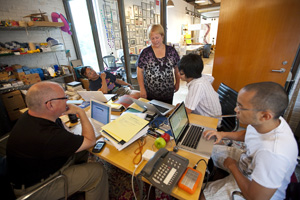Students from technical and artistic backgrounds learn to approach problem solving in a different way

Art and science are closer cousins than they are often recognized as being. That is the theme of a new cross-disciplinary course, taught by biology and art faculty, which explores the connected history and current intersection between the two fields.
Art, Neuroscience, and Consciousness was first offered during the fall semester by Elaine Reynolds, associate professor of biology and chair of neuroscience, and Ed Kerns, Eugene H. Clapp II ’36 Professor of Art. The course is an extension of the Emergent Patterns project, where art and science students worked with Kerns, Reynolds, and Chun Wai Liew, associate professor and head of computer science, to produce the Computation, Vision: Emergence exhibition. Funding for the course was provided by a grant from the Andrew W. Mellon Foundation.
The class studied the connections between art and science that have existed over time, and then examined the current interaction between art and neuroscience in understanding visual processes, perception, self, creativity, and consciousness. They also looked at how the fields can work together to produce models to further understanding of these topics.
“We hope that the course will broaden student thinking and get them to approach their discipline in a different way. It is really a different approach to problem solving–if you think about a problem from a different perspective then you may be able to see a new angle to its solution. I also think the students gained a tremendous amount of respect for each others’ disciplines and a new viewpoint on the universality of knowledge,” Reynolds says.
The class drew the interest of neuroscience, biology, psychology, and art majors, as well as several students who were majoring in two disciplines involving science and humanities.
“I took this class because I had not really had any exposure to art throughout my education and thought it would be interesting to see what correlations could be made through the study of art and neuroscience–two seemingly unrelated areas,” says biology major Alex Crespo ’10 (Monroe, N.Y.). “It was especially interesting to see how artists are able to manipulate the brain into feeling certain emotions with skillful brushstrokes or well placed sketches. I think the most significant learning occurs when people from different educational backgrounds can meet and discuss the viewpoints inherent in their own studies.”
Each class consisted of lectures, discussion, and an active component, which included laboratory or studio work. Students went on a field trip to the Michener Museum in Doylestown. The course also included several guest lecturers. Artist Elizabeth Chapman, who collaborated with Kerns on the art exhibit Word, Mind, City, helped develop this course and was involved in teaching six classes. Students also heard seminars by Oscar, Emmy, and Grammy award-winning documentary director Alex Gibney, and Stacey Marcella, a creator of computer avatars.
“I enjoyed examining art from the perspective of a neuroscientist, as well as bringing my artistic background to scientific tasks such as examining the cell under a microscope,” says art and psychology double major Lisa Mascali ’10 (Manhasset, NY). “I think the interdisciplinary approach is paramount for all students, because we are all more alike than we realize and can benefit from the perspective of those in a complimentary area of study.”
As a final project for the course the students worked in groups to create models of scientific ideas using visual means. The interdisciplinary nature of the material resulted in some interesting projects: panels that reflect musical styles in different ways by using EEG brain waves and expressive painting, a similar project using fMRI and expressive painting, a survey of student attitudes on science and art where the data was represented visually on a male/female figure, a computational project visualizing sound, and models of the developing brain in clay, painting, and even cake.
“Understanding multiple points of view is the first step in cultivating our own humanity,” Kerns says. “I have always collaborated with others–poets, other painters, musicians, dancers, and now scientists. It is a way for me to remain open to self-critical reflection about my own work as well as to extend the synthetic questioning so important to insightful practice.”
 Art and science are closer cousins than they are often recognized as being. That is the theme of a new cross-disciplinary course, taught by biology and art faculty, which explores the connected history and current intersection between the two fields.
Art and science are closer cousins than they are often recognized as being. That is the theme of a new cross-disciplinary course, taught by biology and art faculty, which explores the connected history and current intersection between the two fields.